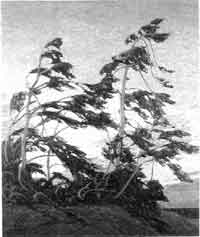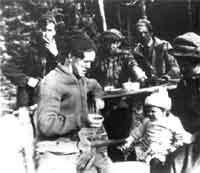 Tom Thomson
Tom Thomson
On the 5th of March, 1913, an exhibition of nine Canadian painters opened at the MacDowell Club in New York. Composed of a young, progressive element that included Lawren Harris, J.E.H. MacDonald, and representatives from the older, more conservative generation, such as Wyly Grier and William Brymner, it had little or no impact. Dominating New York's art scene at that moment was another exhibition familiarly known as the Armory Show, replete with Impressionist and Post Impressionist paintings and works from more recent, advanced movements in European art. It caused an absolute sensation, opening with considerable fanfare on the 17th of February, 1913, almost 25 years to the day after Vincent van Gogh boarded the train from Paris bound for Arles (19th February, 1888). These two events literally changed the course of Western art.
Art in Canada, in 1913, was also in the process of change, although the change was less radical, and less intellectual. Nevertheless the country was on the verge of being enriched by the modest endeavors of several young artists who were responding to European developments in painting techniques, by adapting them to their own visions of a national art. Canadian artists of this new generation may well have received affirmation of the direction they were taking from the Arts and Letters Club of Toronto's Yearbook of Canadian Art, 1913, where they would have read Wyly Grier's prescription "[t]hat art will never hold a commanding position (Ó) until we are stirred by big emotions born of our landscapeÓ" Already, Lawren Harris, J.E.H. MacDonald, Arthur Lismer, A.Y. Jackson (the core members of the future Group of Seven), together with Tom Thomson, felt compelled to capture the true nature of the northern landscape. In the second half of that year, Thomson's personal style had coalesced, and he began to produce the body of works which would turn him into a national icon. The best of these were scenes from Algonquin Park where he found his spiritual home.
The new Tom Thomson exhibition which will be crisscrossing the country until the end of next year, is accompanied by a "grand-piano" book, intended to fulfill the objectives of the Directors of the National Gallery, and of the Art Gallery of Ontario, by taking "[a] fresh look at Thomson's life and times, to provide a perspective from the vantage point of new information, interpretations and methodologies." This book, which contains five essays and one technical study, was conceived as the work of several specialist contributors. Do these specialists combine to achieve this goal? The answer is no.
The first and most informative essay, "Mapping Tom" by Andrew Hunter, reflects the northern content of the exhibition. It is not entirely successful. While Hunter does mention some of Thomson's artist predecessors as having visited Algonquin Park, he does not include any reference to the earliest group of artists who ventured there: In the summer of 1903, three members of the Toronto Art Student's League¨Robert Holmes, W.W. Alexander and David Thomson¨ left from Canoe Lake on a sketching and painting trip. This omission is slight, however, when compared with Hunter's assertion that "the First World War is significant to any consideration of Tom ThomsonÓ," but subsequent failure to explore the significance of this statement in any depth. Yet, it was in this period¨bounded by the outbreak of war and by his untimely death, just three months after the battle of Vimy Ridge¨that the painter flourished. Only three pages are devoted to the effects of war on Thomson and his fellow artists, with hardly any reference to the war's impact on the Park, its residents, or on Toronto and the infant art scene there. Nor is there a resolution here to the question of whether or not Thomson volunteered (only to be rejected). Furthermore, the essayist's somewhat crass point that "the war kept a number of key Thomson 'biographers' away from him during the critical years of 1914-1917," should have been omitted.
 Pine Island, Georgian Bay (1914-16, oil on canvas)
Pine Island, Georgian Bay (1914-16, oil on canvas)
Hunter's essay is followed by two impressive, well written contributions: Robert Stacey's piece on Thomson as an applied artist is one; the other essay, by the Art Gallery of Ontario's curator of Canadian paintings, Dennis Reid, explores the artist's possible links to the Arts and Crafts movement. Although both offer new insights, these essays seem to be fillers, and too esoteric for a book that accompanies a major exhibition which is pertinently focused on the selection of 130 sketches and canvases from the last four years of Thomson's life. They more properly belong to learned art journals.
Precedence might more appropriately have been given to tracing the origins of the techniques that resulted in the style, the compositions, and use of color which were purely Thomson's. Most of this knowledge seems to have been learned from his artist friends who gained their experience by studying in Europe, something Thomson had not done. In his essay "Tom Thomson, Painter," Charles Hill, the National Gallery curator of Canadian paintings, provides little detail about these influences on Thomson's artistic development. Where Hill does excel, is in his descriptive analysis of the sketches and canvases of Thomson's mature period.
Like Hunter's, John Wadland's contribution, "Tom Thomson's Places," is a lively re-creation of the period, leading the reader through "the essence of his [Thomson's] life." Wadland might have applied his research skills to Thomson's connection with Hamilton, which is left as an uninvestigated gap among the "urban spaces" referred to. There is more to be drawn out than what Stacey refers to as Thomson's possible employment with the "prestigious" Reid Press. One Hamilton friend of Thomson's was the artist and respected art teacher John Sloan Gordon. They met over the years in the Park when Gordon summered there at Camp Nominigen on Smoke Lake with prominent Hamilton photographer A.M. Cunningham and family.
It is of interest that Gordon had laid the foundation for his art reference library during his studies in Paris, from 1895-96. Just as there is little in the book on the contributions of Thomson's friends to his development as an artist, so there is nothing on the importance of art reference material of all types as a source of information on new developments in art, from which Thomson might have benefited. Had Hill taken this into account, he might have refuted A.Y. Jackson's assertion that "artists in Toronto were woefully lacking in information about trends in other parts of the worldÓ" The fact that relevant books, exhibition catalogues, press reviews and other articles published in major centers in Canada or America before 1913 do not figure in the book's bibliography, nor is any mention made of photographs, postcards and reproductions from the period, points to the need for more research. There is a brief story in Tom Thomson: The Silence and the Storm in which Jackson, contradicting himself, recalled that "Thomson was keenly interested in Vincent van Gogh," leading to the presumption that somehow Thomson did have access to illustrations, and that more might have been made of these influences.
 Thomson, F.H. Varley, A.Y. Jackson, Arthur, Marjorie and Esther Lismer in Algonquin Park, likely photographed by Maud Varley, October 1914
Thomson, F.H. Varley, A.Y. Jackson, Arthur, Marjorie and Esther Lismer in Algonquin Park, likely photographed by Maud Varley, October 1914
One inclusion in the bibliography is the name of Ian Wainwright, author of a report that was a groundbreaking predecessor to the contribution of Sandra Webster-Cook and Anne Ruggles of the Canadian Conservation Institute in this volume. Their essay, "Technical Studies", conveys to the general reader an obvious enthusiasm for the patient, scientific detective work involved in their labour, and is delivered in a manner which is easy to read. Oddly though, they do not refer to the work undertaken by Wainwright and his team in 1990, when the authenticity of a privately owned double-sided Thomson panel, entitled Spring Landscape with Snow/Northern Mist, was maliciously challenged by the dealer, the late Blair Laing. Reid and Hill, who considered it to be genuine, persuaded the CCI to undertake a comparative study of the estate stamped panel, against reference panels from the National Gallery. Wainwright found nothing to indicate that it was a fake. Indeed, his conclusion pointed to a consistency between the materials used for the double-sided panel, and those used for the other reference panels. The current exhibition would have been an ideal opportunity to endorse the authenticity of Spring Landscape with Snow/Northern Mist by including it. Setting aside Kenneth Thompson's large contribution to the show, the number of sketches from other private collections is only seven, and Northern Mist, the earlier of the two panel paintings, is of greater merit than many the 53 sketches chosen from all sources.
In time, many of the shortcomings of this weighty tome may be redressed, although this will be unlikely before the centennial of Thomson's death in 2017. ˛
For more than 30 years, David Mitchell has been an independent Canadian art specialist with emphasis on Tom Thomson and the Group of Seven. Currently, after six years of research he has a book in progress on his scholarly authentication of the world's most hotly contested painting¨Van Gogh's "Yasuda" Sunflowers.